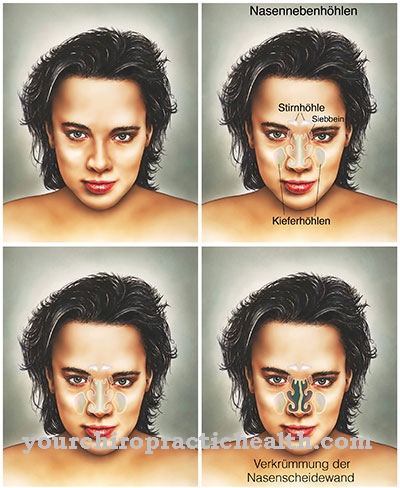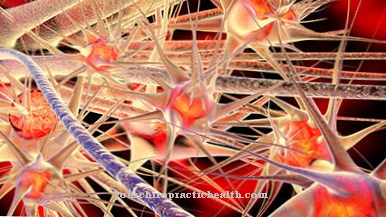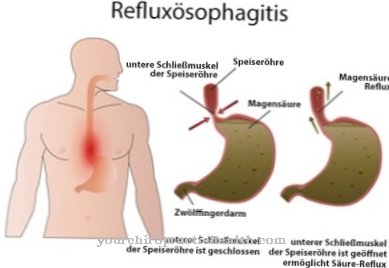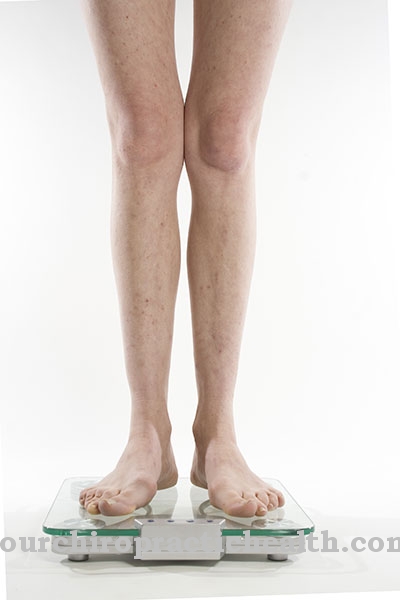Tendinosis calcarea is the medical term for a Tendon calcification. Most often this shows up in the shoulder.
What is a tendinosis calcarea?

© Joel bubble ben - stock.adobe.com
From one Tendinosis calcarea is the talk when there is calcification of different tendons. It comes about through the deposition of calcium crystals. In principle, a tendinosis calcarea can occur on any body tendon, but in most cases it appears on the shoulder tendons such as the supraspinatus tendon of the supraspinatus muscle. Doctors then speak of one Lime shoulder.
Sometimes a tendinosis calcarea also develops on the patellar tendon of the knee or on the Achilles tendon. Occasionally the rotator cuff is also of one Tendon calcification affected. In most cases, calcar tendinosis occurs between the ages of 40 and 50 years. Tendon calcifications are slightly more common in women than men. It is estimated that two to three out of 100 people have a tendinosis calcarea.
causes
How a tendinosis calcarea develops is not yet known. Degenerative tendon changes are suspected. The pressure on the affected tendons is increased by signs of wear and tear, for which the natural aging process and weaker blood circulation are responsible. As a result, calcium crystals accumulate in the tissue, causing painful discomfort when performing movements.
At the shoulder joint, the crystals cause the tendon to thicken, which means that when the affected arm is lifted, it is trapped between the roof of the shoulder and the shoulder joint, which in turn causes pain. As the tendinosis calcarea continues, the body's defense system sends macrophages. These are special immune cells that are supposed to break down the crystals. This causes the tissue to scar and the tendon to continue to thicken.
Symptoms, ailments & signs
The symptoms of a tendinosis calcarea depend on which tendon it occurs. If the calcification shows up on the shoulder, there is pain when the arm is raised. The same applies if the person concerned lies on their side.
In some cases, arm movement is no longer possible at all, which is known as pseudoparalysis. The longer the tendinosis calcarea lasts, the more the symptoms worsen. In the further course of the disease, there is a risk of the calcification of the tendons in the shoulder joint. The consequence of this is inflammation of the bursae, which is accompanied by pronounced pain.
There is also redness and an overheated joint. Pain-free movements can usually only be carried out when the arm is spread apart, when it is turned outwards or inwards. Secondary complaints from the tendinosis calcarea such as neck tension or headaches can also occur.
As a result of pain-avoiding awkward movements, neck muscles are often tense. Sometimes the complaints in the neck are so intense that the tendinosis calcarea is no longer registered. In some people, the calcification of the tendons does not cause any symptoms, so their diagnosis is purely coincidental.
Diagnosis & course of disease
If a tendinosis calcarea is suspected, the patient should contact an orthopedic surgeon who specializes in this type of complaint. The detection of calcification of the tendons is usually already possible through a sonography (ultrasound examination). The lime hearth causes a sound extinction, which can be determined during the investigation.
In addition, the precise position of the calcium deposit can be determined with sonography. This makes it easier for the doctor to track down the calcium focus, which has a positive effect on the planning of a surgical procedure. With a tendinosis calcarea, the thickening is always in the middle of the tendon.
An X-ray examination is another possible diagnostic method. The calcifications of the tendons are usually clearly visible on the X-rays. In order to precisely determine the lime source, however, recordings from several angles are required. The course of the tendinosis calcarea varies from person to person. So there is a possibility that the pain will increase rapidly.
Complications
They can also fail slightly for a longer period of time. It is not uncommon for painful inflammations to occur due to calcium deposits, which, however, break down the calcium. In some patients, the calcification of the tendons regresses on its own due to the body's self-healing process, while in others an operation has to be performed.
Tendinosis calcarea can cause different complications, depending on which tendon it appears. If the calcification occurs on the shoulder, there is pain when moving the arm. In severe cases, the arm can no longer be moved at all. This pseudoparalysis worsens as the disease progresses and can eventually lead to complete calcification of the tendons in the shoulder joint.
A possible consequence of this is bursitis, which is always associated with severe pain and the risk of further infections. In addition, redness and overheating occur in the affected joint. In individual cases, those affected suffer from headaches and tension in the shoulder and neck area. The treatment of tendinosis calcarea also carries risks. Occasionally, side effects and interactions occur after taking pain reliever medication.
Patients who already suffer from a disease of the cardiovascular system or the immune system are particularly susceptible to acute complaints and long-term effects. Typical complications are, for example, gastrointestinal complaints, headaches, muscle and limb pain, skin irritations and muscle weakness. In the long term, it can damage the heart, kidneys and liver. The usual complications are conceivable in the course of a surgical procedure: bleeding, nerve injuries, infections and wound healing disorders.
When should you go to the doctor?
Medical treatment should always be carried out for tendinosis calcarea. There is also no independent healing, so that the person concerned is always dependent on treatment by a doctor. If the tendinosis calcarea is not treated, further complications occur and the symptoms worsen. For this reason, a doctor should be contacted at the first symptoms of the disease. The doctor should be consulted if the person concerned suffers from severe pain in the arm. These occur for no particular reason and do not go away on their own. They can also occur in the form of pain at rest and have a very negative effect on the person's quality of life.
Reddening of the affected area is also not infrequently an indication of the tendinosis calcarea and must be checked by a doctor. The disease can also manifest itself as severe pain in the head or neck. If the symptoms of tendinosis calcarea occur, either an orthopedic surgeon or a general practitioner can be contacted.
Treatment & Therapy
Tendinosis calcarea can be treated conservatively or surgically. As part of conservative treatment, the patient is given pain relievers such as non-steroidal anti-inflammatory drugs (NSAIDs). Sports activities or gymnastic exercises are better avoided because they worsen the pain.
The orthopedic surgeon also has the option of injecting local pain relievers directly into the affected area of the body. Shockwave treatment is a treatment option for a calcified shoulder. With this procedure, a short, intense pressure pulse is emitted, which leads to better blood circulation in the tissue. In addition, new blood vessels form and the calcium deposit dissolves. As the tension pressure drops, the pain goes down.
If the symptoms persist unabated despite conservative treatment, an operation must be performed, which is seldom the case due to the high spontaneous healing rate. The surgeon removes the calcium deposits and expands the subacromial space. The procedure is usually done through minimally invasive arthroscopy. After the operation, the patient has to take it easy for about three weeks.
prevention
To prevent tendinosis calcarea, doctors recommend a diet rich in magnesium. Foods containing magnesium mainly include nuts and whole grain products.
Aftercare
If the tendinosis calcarea has to be treated surgically, follow-up care is extremely important. The affected shoulder should be spared for about three weeks after the surgical procedure. To treat the pain, the patient is given drugs that have analgesic and anti-inflammatory effects.
The following physiotherapeutic exercises are an important part of the aftercare of a calcified shoulder. They take place after the acute pain has subsided. After the tendon has healed, a pain-adapted mobilization treatment is carried out. If passive exercises are carried out in the first phase of therapy, active exercises are carried out in the second phase, which are useful for achieving full freedom of movement of the shoulder joint.
Pain-adapted therapy is understood to mean exercises that only load the shoulder as much as the pain allows. The pain threshold must not be exceeded. The postoperative follow-up treatment also includes a third phase. Within this framework, the stability, strength and muscle coordination of the affected shoulder can be completely restored.
After a calcified shoulder surgery, the pain usually subsides after 24 to 48 hours. Therefore, further follow-up treatment, which is carried out on an outpatient basis, can usually be carried out without difficulty. The general state of health and any previous illnesses of the patient are also important. Long-term satisfaction can be achieved through follow-up care in around 90 percent of patients.
You can do that yourself
Patients with tendinosis calcarea primarily suffer from recurring pain, which increases in frequency and severity as the disease progresses. Those affected, however, must be aware that calcar tendinosis cannot be treated by self-help measures alone. Relief of the symptoms through self-help measures is usually only temporary. Because if there is no medical intervention and therapy, the tendinosis calcarea progresses increasingly, which increases the pain.
In general, physiotherapeutic measures are considered to be a good way to reduce some of the symptoms caused by the tendinosis calcarea and to promote muscles and mobility.
However, if these conservative therapy methods do not show the desired success, the patients usually have to undergo an operation. Here, too, those affected have the opportunity to positively influence the outcome of the operative intervention through active participation. Do not exercise before and especially after the procedure. After the operation, patients with tendinosis calcarea also strictly adhere to the medical guidelines regarding physical restraint. With targeted scar care, those affected can help the surgical scars heal as well as possible and prevent infections. Patients only do sports again after they have given their doctor's permission.

.jpg)
.jpg)





















.jpg)



